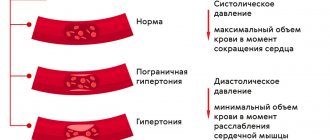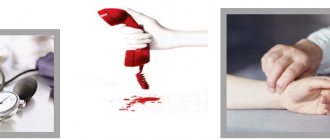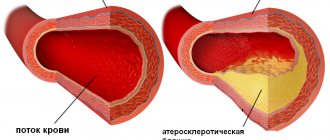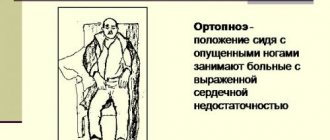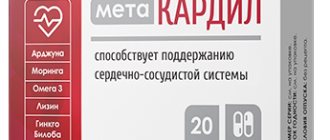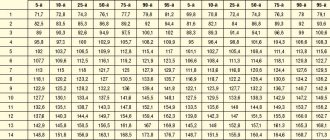Stage 3 hypertension is a disease characterized by a persistent increase in blood pressure and is a consequence of target organ damage. Hypertension of the third degree is severe, because complications negatively affect the patient’s quality of life. In some cases, death is likely.
- Causes
- Symptoms of stage 3 hypertension
- Diagnostics
- Treatment of stage 3 hypertension
- Nutrition for stage 3 hypertension
- Sample menu for stage 3 hypertension
- Prevention
- Forecast
- Disability due to hypertension 3rd degree
Causes
Causes of grade 3 hypertension include insufficient therapy. If you get an inexperienced doctor and develop a poor treatment regimen, the symptoms may worsen. If the patient himself does not comply with the doctor’s instructions, this can also threaten the worsening of hypertension. Also, the development of the disease is influenced by pathologies that develop in parallel with an increase in blood pressure.
Risk No. 3 with second-degree hypertension exists if the patient is expected to have a 20-30% chance of developing complications from the cardiovascular system. This risk is observed in patients diagnosed with diabetes mellitus. If you have impaired filtration of fluids by the kidneys, as well as atherosclerotic plaques, you are also at risk. In this condition, a person is diagnosed with stable angina pectoris. It determines the 3rd degree of risk, including young patients. A complete cure today is incredible; it is possible to slow down the disease and prevent complications.
Causes and risk factors
Despite many years of active research, there is no unifying hypothesis to account for the pathogenesis (mechanism of occurrence) of hypertension. In chronic long-standing hypertension, blood volume and cardiac output are often normal, so hypertension is maintained by increased systemic vascular resistance rather than increased cardiac output. There is also evidence of increased vascular tone. In addition, disturbances in the nervous and endocrine regulation of blood pressure play a role in the development of the disease.
Many factors can affect blood pressure, including:
- Genetic, which play an important role in the occurrence of hypertension.
- How much water and salt is in your body.
- The condition of your kidneys, nervous system and blood vessels.
- Levels of various body hormones.
- Age. Blood pressure gets higher as you get older. This is because blood vessels become stiffer as a person ages.
You are at increased risk of hypertension if you:
- Are you obese?
- Frequently experience stress or anxiety;
- Drinking too much alcohol;
- Consume too much salt;
- Have a family history of the disease:
- Diabetic;
- Smoke;
- You lead a sedentary lifestyle;
- You are experiencing stress.
Symptoms of stage 3 hypertension
Symptoms include not only manifestations of hypertension, but also signs of target organ pathology. The pathological process concerns mainly the brain. Ischemic and hemorrhagic strokes are possible. Blood vessels are affected, as are the structures of the central nervous system. Kidney function is also impaired, which further aggravates hypertension and the severity of the disease increases.
On the part of the heart, myocardial infarction and hemodynamic instability may develop. Vision also suffers. Some patients experience damage to the vessels of the retina. Arteries can dilate, forming aneurysms. In some cases, encephalopathy develops and hematomas form inside the skull or inside the brain.
What does each stage of hypertension mean: a brief description
Classification of hypertension by stages involves assessing the possible total risks of damage to other organs and the development of complications associated with hypertension. The data is presented in the table below:
| Stage I | There are no signs of damage or objective symptoms. |
| Stage II | In the absence of clinical symptoms, the patient has signs of:
|
| Stage III | There are signs of target organ damage and the patient presents characteristic symptoms:
|
Diagnostics
Interviewing the patient himself is important for diagnosis. Main complaints:
- nausea
- headache
- sensation of vascular pulsation
- persistent dizziness
- increased heart rate
- swelling
- muscle weakness
Systematic and technically correct blood pressure measurement is important. Over the course of 2 weeks, measurements should be taken by a doctor 2 times to obtain dynamic data. Blood pressure measurements are the physical diagnosis of stage 3 hypertension. It allows you to assess the condition of peripheral vessels for the presence of edema. This technique makes it possible to listen to the lungs and heart, perform percussion of the vascular bundle and determine the configuration of the heart.
In each specific case, the doctor may prescribe studies of the heart and kidneys, because their pathologies are closely related to grade 3 increased blood pressure. Most often they resort to ultrasound diagnostics, which shows the condition of the kidneys, liver, pancreas and endocrine glands.
conclusions
High blood pressure significantly increases the risk of developing serious cardiovascular complications and premature mortality. The main reason for this is essential hypertension, less often secondary, associated with damage to the organs that regulate blood pressure. When conducting an examination and making a diagnosis, the stage must be taken into account. The classification makes it possible to establish the nature of target organ damage, formulate treatment tactics and assess the prognosis. Timely treatment can reduce the risk of disability and improve the quality of life of each patient.
Treatment of stage 3 hypertension
Therapy includes several stages. The patient should lead an active lifestyle. The doctor prescribes dosed physical activity that will be tolerated normally by a particular patient. A person must adhere to a certain schedule of rest and work. The results are visible only after a long time, not immediately. Nutrition is also part of the therapy. A special diet is required. Pay attention to the amount of drinking to maintain a normal water-electrolyte balance.
Self-medication with medications is unacceptable because this is a serious illness. Drug treatment is purely individual. Cardosal and Rasilez are effective. They are effective for essential hypertension. Cardosal is given to the patient once every 24 hours, before, during or after meals. The dosage prescribed in the instructions can be increased several times on an individual basis. This can only be decided by your attending physician.
Rasilez is used for the treatment of grade 3 hypertension as monotherapy or in combination with other drugs that are classified as antihypertensive. The daily dose is 150 mg; medication intake does not depend on food intake. The results of this treatment will be visible after 14 days (on average).
Which doctor treats hypertension
A cardiologist treats hypertension. Also, treatment of hypertension can be carried out by a general practitioner (general practitioner or family doctor), who often detects high blood pressure when contacting him with complaints of poor health.
Drug therapy
Medicines should be selected by a doctor, who does this taking into account the individual characteristics of each patient.
Lifestyle change
First of all, you need to:
- stop smoking;
- eliminate or reduce alcohol consumption;
- try to reduce weight to normal;
- reduce salt intake to 5 g/day;
- provide regular physical activity. The most beneficial are walking, swimming and therapeutic exercises;
- increase your resistance to stress;
- optimize nutrition (eat more greens, fruits, foods with a significant content of potassium, calcium and magnesium, and, conversely, reduce the consumption of vegetable fats and protein foods). You should eat regularly.
Make an appointment Do not self-medicate. Contact our specialists who will correctly diagnose and prescribe treatment.
Nutrition for stage 3 hypertension
Products useful for hypertension include:
- curdled milk
- cottage cheese (not very fatty)
- boiled beef
- whey
- egg white
- peas
- green onions
- black currants
- lemons
- radish
Some of the above mentioned foods help remove toxins from the body. Salt should be consumed minimally; it is advisable to avoid adding salt to dishes. The body should receive up to ½ tsp of salt per day.
Products prohibited for grade 3 hypertension:
- pickles
- spices
- spicy dishes
- smoked meats
The above products increase blood pressure. It is also better to exclude caffeine (and drinks containing it) and oil-based confectionery products from your diet. Alcohol should be avoided if you have hypertension.
It is recommended to use ginger, which has medicinal properties. It is also used to prevent hypertension. Ginger can be added to tea (or to make an all-ginger tea), main dishes, baked goods and desserts. Ginger relaxes muscles (around blood vessels) and thins the blood.
It is worth giving up semi-finished products, products of unknown origin, and fatty foods. Overeating is prohibited for hypertensive patients.
Sample menu for stage 3 hypertension
Day 1. In the morning we have breakfast with meat soufflé and porridge cooked in milk. You can drink tea. There is no feeling of heaviness in the gastrointestinal tract after such a breakfast, but satiety is present. After a few hours, eat 1-2 apples. Lunch: chicken broth soup and rice with chicken. For dessert you can have compote. Next meal: crackers with sugar and rosehip infusion. You can make crackers yourself. For dinner, fish with carrot garnish is suitable. Before going to bed, drink kefir or yogurt.
Day 2. Have buckwheat for breakfast and drink tea with milk. Second breakfast: carrot juice (freshly squeezed) or a decoction of dried black currants. Lunch: borscht with a decoction of wheat bran and pilaf with dried apricots. For lunch, you can give the patient a rosehip decoction as a drink. You can have fruit juice in the afternoon. No dinner (or any fermented milk product). Before going to bed, it would be a good idea to drink a rosehip decoction.
Day 3. For breakfast, a good option would be buckwheat or oatmeal mixed with chopped apple or carrot. Your favorite tea is suitable for drinking. Second breakfast: soaked dried apricots or dates. For lunch you can serve borscht, fried meat, cabbage salad, blackcurrant jelly (you can add other berries and fruits). Afternoon snack: fresh apples. For dinner they make carrot cutlets and cottage cheese soufflé; drink: tea with lemon (or jam). Before going to bed, you can drink ½ glass of rosehip decoction.
Day 4. For tomorrow, serve cottage cheese with stale bread or crackers, butter, jam/preserve and black/green tea. It is better to avoid strong brewed tea, which has a direct effect on blood pressure. On the fourth day, you can serve boiled fish, vegetable puree or stew for lunch. Fresh carrot juice is suitable as a drink (you can use carrot-apple or carrot-celery). Apples are given for afternoon snack. Buckwheat and yogurt are suitable for dinner. Half an hour before bedtime, you can drink 200-250 ml of kefir.
Day 5. For breakfast, any porridge with milk or a bun (preferably whole grain or dark flour) is suitable. Fruits are suitable for a second breakfast. For lunch on the 5th day, you can offer noodle soup and turkey meatballs. As a snack after 1.5-2.5 hours, you can eat a baked apple with the addition of a small amount of sugar or honey. On the 5th day, kefir or yogurt without additives is given as an afternoon snack. Lazy dumplings and tea with milk are prepared for dinner. In the evening, you can take a rosehip decoction.
Day 6. For breakfast, boil 1-3 chicken eggs. They eat it with stale bread (preferably dark) and milk with honey. Juice from fruits and/or berries is suitable as a second breakfast. Vegetable soup and cottage cheese soufflé are served for lunch. You can also prepare a vinaigrette or other vegetable salad seasoned with vegetable oil. Plum compote is suitable as a drink. As an afternoon snack, an excellent option would be to serve fruit jelly or fruit and berry mousse. For dinner, give boiled potatoes and lean ham in the amount of 50-70 grams.
Day 7. For your first breakfast, you can serve buckwheat with a salad based on lettuce or cabbage. Drink for breakfast: coffee/tea with milk. Second breakfast: steamed raisins and fresh vegetables. Lunch: potato soup without meat and rice pilaf. For an afternoon snack, give them soaked dried apricots or dates. For dinner, jellied fish with potato cutlets is suitable; drink: tea with milk. 30-40 minutes before bedtime, drink a glass of kefir or sourdough.
Symptoms
Symptoms of malignant hypertension can be lightning fast and sudden. At indicators of 300-150/160-130 mm Hg. Art. The area of the heart, brain, kidneys and fundus is affected. Sometimes acute pancreatitis develops. Against the background of acute pain under the peritoneum, symptoms of progressive necrotizing vasculitis appear; fibrinoid necrosis of the intestine and pancreatic vessels is possible.
Early and frequent manifestations of retinopathy due to vascular pathology are noted: the optic disc swells on both sides, hemorrhages and exudates appear in the retina. They are considered to be unique markers of the malignancy of the pathology. A swollen disc may be a sign of other problems, such as intracranial pressure impairing venous drainage.
The leading symptom of malignancy, which manifests itself early, is hypertensive encephalopathy with a swollen brain. It is confirmed when:
- intense and persistent headaches;
- dizziness, nausea and vomiting;
- blackout, stupor and coma.
Encephalopathy disrupts the autoregulation of cerebral blood flow. There is no stability of blood flow, as with indicators of 110-180 mm. rt. Art. The pressure rises, and the upper border of the arteriole involuntarily expands. Due to this, hyperperfusion, cerebral edema and hypertensive encephalopathy occur. And it can be complicated by strokes: hemorrhagic or ischemic.
The skin of patients dries out and becomes pale with an earthy tint. Body weight is rapidly lost, kidney failure and anemia develop. Its symptoms appear because red blood cells are damaged during fibrinoid necrosis of arterioles and productive endarteritis. Their integrity is disrupted and microangiopathic hemolytic anemia is caused by fibrinoid deposits on the capillary walls.
Malignant pathology develops in parallel with progressive kidney damage. Reasons for this union:
- nephroangiosclerosis;
- increased creatinine levels;
- urea in the blood;
- increasing uremia;
- decreased glomerular filtration rate;
- deterioration of tubular secretion (reabsorption).
When examining urine, note:
- Decreased ability of the kidney to concentrate dense particles in the urine.
- Presence of microhematuria and proteinuria.
The kidneys can be of normal size in the presence of eclampsia and the rapid development of the disease, or reduced in size during the transition from chronic to malignant hypertension. At the same time, the cardiovascular system changes rapidly:
- its insufficiency progresses, up to pulmonary edema;
- coronary heart disease is destabilized;
- arrhythmias occur.
Active treatment allows 70% of patients with malignant hypertension to survive for 5 years. If there is no impairment of kidney function, then 96% of patients survive, with kidney failure - 65%.
A common cause of death is myocardial infarction and renal failure. The manifestation of malignancy is noted against the background of hypertension in 1-3% of cases. With renal artery stenosis - in 20-25% of cases. It also manifests itself in the presence of primary aldosteronism, pheochromocytoma, and parenchymal kidney disease. Secondary hypertension accounts for less than 10%.
A particularly severe course is characterized by malignant hypertension against the background of collagen diseases, such as scleroderma, systemic lupus erythematosus, and periarteritis nodosa.
These diseases quickly and significantly increase the activity of renin in the blood plasma. Young people aged 40 or more and older people get sick. Therefore, isolated systolic hypertension also becomes malignant, especially in the presence of renal artery stenosis with pre-existing hypertension.
Prevention
To prevent high blood pressure, the following measures are important:
- dosed physical activity (tones the cardiovascular system)
- maintaining weight within normal limits (with obesity, the risk of diabetes and hypertension increases, among the most serious complications is coronary artery disease)
- getting rid of bad habits, including smoking and drinking alcohol (nicotine constricts blood vessels)
- proper rest after a working day and/or physical activity
- active recreation for knowledge workers
- periodic blood tests for sugar levels
- periodic blood pressure measurement
- ECG of the heart 1-3 times a year
Grodno University Clinic
Hypertension, hypertension, is a chronic disease characterized in the initial stages by periodic and then constant increases in blood pressure.
Normal blood pressure numbers:
- 16-20 years - 100-120/70-80 mm Hg. Art.;
- 20-40 years - 120-130/70-80 mm Hg. Art.;
- 40-60 years - up to 140/90 mmHg. Art.;
- over 60 years old - up to 140-150/90 mmHg. Art.
Causes of development of hypertension
- Heredity;
- Floor. Men are more predisposed to developing arterial hypertension, especially at the age of 35-50 years. However, after menopause, the risk also increases significantly in women;
- Age. High blood pressure most often develops in people over 35 years of age, and the older the person, the higher their blood pressure numbers tend to be.
- Stress and mental strain;
- Alcohol consumption;
- Atherosclerosis. Excess cholesterol leads to loss of elasticity in the arteries, and atherosclerotic plaques narrow the lumen of blood vessels, which makes it difficult for the heart to function. All this leads to increased blood pressure. However, hypertension, in turn, spurs the development of atherosclerosis, so these diseases are risk factors for each other;
- Smoking;
- Excess dietary sodium. Excess salt in the body often leads to spasm of the arteries, fluid retention in the body and, as a result, to the development of arterial hypertension.
- Physical inactivity; People who lead a sedentary lifestyle are 20-50% more likely to develop hypertension than those who are actively involved in sports or physical labor.
- Obesity; Overweight people have higher blood pressure than thin people. This is not surprising, since obesity is often associated with other listed factors - an abundance of animal fats in the diet (which causes atherosclerosis), consumption of salty foods, and low physical activity.
Symptoms of hypertension.
The disease rarely begins in people under 30 years of age and over 60 years of age. An increase in blood pressure above the normal level is accompanied by headache, noise in the head, sleep disturbance, and decreased mental performance.
Dizziness and nosebleeds are possible.
Hypertension is chronic with periods of deterioration and improvement.
If you have counted at least two risk factors, the danger of developing hypertension is already quite high! We advise you to pay attention to prevention!
Prevention of arterial hypertension:
Physical exercise. Any physical exercise in persons with mild and moderate hypertension helps to increase physical performance. Exercises aimed at training endurance (general developmental exercises, breathing exercises, exercise equipment, swimming, walking, running) lead to a noticeable antihypertensive effect. It's best to exercise a little (30 minutes) every day, gradually increasing the intensity from light to moderate.
Low salt diet. The amount of table salt should be limited to 5 grams (1 teaspoon) per day. It should be noted that many products (cheeses, smoked and pickled products, sausages, canned food, mayonnaise, chips) themselves contain a lot of salt. Replace salt with herbs and garlic.
Limiting animal fats. Gradually replace butter, cheeses, sausages, sour cream, lard and fried cutlets from your diet with additional vegetables and fruits, vegetable oil and lean fish. Prefer low-fat dairy products. This way you can control cholesterol levels in the blood (prevention of atherosclerosis), normalize weight and at the same time enrich your diet with potassium, which is very useful for hypertension.
Psychological relief. Stress is one of the main causes of high blood pressure. That’s why it’s so important to master methods of psychological relief - auto-training, self-hypnosis, meditation. Hiking, sports, hobbies and spending time with pets also help maintain mental balance.
Rejection of bad habits. Bad habits and arterial hypertension are a terrible combination, which in most cases leads to tragic consequences.
Treatment of hypertension. Drug treatment of hypertension should be constant over a number of years. It is carried out under the supervision of a doctor.
Non-drug therapy. In addition to the already repeatedly mentioned hypertensive diet, therapy may include physical therapy, light massage of the collar area, acupuncture, acupuncture, reflexology, exposure to physical factors (general magnetotherapy, magnesium electrophoresis according to Vermeule, darsonvalization of the scalp and collar area, electrosleep, laser therapy on the projection area main arteries of the head, ultrasound therapy of the cervical-collar area, dry carbon dioxide bath). It is also necessary to normalize sleep, maintain a daily routine, take natural and synthetic vitamins, antioxidants and restorative herbs. In short, it’s worthwhile to “improve” your lifestyle as much as possible.
Physiotherapist of the Physiotherapeutic Department Lelesh L.A.
Forecast
The prognosis depends on the stage of the disease. At the onset of hypertension, the patient is not in serious danger, and the prognosis can be considered favorable. The condition worsens with severe or rapid progression of the disease. If there are sclerotic changes in the vessels, the prognosis is worse. At stage 3, the prognosis is often poor. Severe damage to blood vessels and organs occurs. The prognosis improves with strict adherence to the doctor’s recommendations and implementation of the treatment regimen. It is important to remember that it is complex treatment that matters.
Development mechanisms
The pathology is accompanied by high blood pressure from 160-100 to 180-120 mm. rt. pillar Arterial hypertension is considered malignant at levels of 220-125 mm. rt. pillar At the same time, changes in the fundus of the eye are already visible in the form of papilledema, third stage retinopathy of the retina - a disorder due to vascular disorders. Hemorrhages (blood loss from blood vessels) and exudates (serous fluid) appear in the retina.
People with normal or low blood pressure may develop malignant hypertension if the readings begin to rise rapidly to 150/100, 160/110 or 180/120 mm. rt. pillar If there is a history of hypertension for a long time, and arterial pressure increased gradually, then its high level does not cause such changes to the patient as sudden malignant hypertension.
Why the disease develops and crises occur is unknown. Science has not yet proven why hypertension in some cases is not malignant, but in others it causes dangerous diseases and death. It is assumed that with a rapid and significant increase in pressure, processes occur that pathomorphologically change the vessels. This leads to the development of tissue ischemia. When malignancy occurs:
- The following systems are activated: tissue and humoral pressor systems.
- There is a massive release of vasoconstrictor agents: angiotensin II, endothelin-1, vasopressin, catecholamines.
- The endothelium is damaged, mitogenic factors and platelet aggregation are activated.
- Fibrin is deposited in the vessels, which develops productive endarteritis and further fibrinoid necrosis.
If malignant arterial hypertension, vasoconstriction and fibrinoid necrosis of arterioles develop, then under the influence of humoral vasopressor factors, tissue ischemia further worsens. In this regard, systemic and renal pressure increases.
If intraglomerular pressure increases, then sodium ions are removed from the kidneys, and hypovolemia develops. And it releases vasoconstrictor factors. A vicious circle is created, since with all these changes, the pressure continues to rise, and internal organs are ischemically affected. Sodium reserves are depleted, hypovolemia develops, and signs of malignant hypertension appear, which affects treatment tactics:
- lack of water and sodium;
- hypokalemia appears with high aldosterone;
- Plasma renin is activated;
- Aldosterone levels increase.
These symptoms disrupt renal hemodynamics, provoke “pressure natriuresis” and hypovolemia, and it stimulates the reninaldosterone system.
Disability due to hypertension 3rd degree
Assignment of disability for hypertension of the 3rd degree is probable. If severe damage to the heart, kidneys, brain and eyes occurs, the person is considered disabled. Some of the patients are recognized as partially able to work (they can perform their duties at home).
There may be, as we have already noted, severe complications from the kidneys, heart and brain, then a second disability group is assigned, rarely - the first. Patients with hypertension should be constantly monitored at the dispensary. Periodic examinations, special rehabilitation courses and health treatments in sanatoriums can help a person feel much better. But resorts must be selected individually. If a person’s condition is either mild or severe, it is better to refuse treatment at resorts.
Prognosis of a patient with a certain stage of hypertension
In addition to assessing the effect of the prescribed treatment, special attention is paid to calculating the further prognosis. Complete recovery from hypertension is impossible, but the initiation of timely therapy can improve the patient’s quality of life.
According to the latest medical data:
- Patients with the first stage of hypertension are at the lowest risk; the target criterion is a pressure of no more than 140/90 mmHg.
In the second stage, the risk of complications increases. Against the background of persistent high blood pressure, changes in the retinal arteries, left ventricular hypertrophy. The situation is aggravated by progressive atherosclerosis, impaired renal filtration, and frequent attacks of chest pain.- In the third stage, there is a high risk of death due to a hypertensive crisis, disability and persistent loss of working capacity. A sharp increase in pressure over 180/90 mmHg. can provoke a stroke or cerebral infarction, vascular dementia.
- Long-term progressive chronic hypertension leads to the following complications: nephrosclerosis and renal failure, thrombosis (blockage) of peripheral vessels and the development of gangrene of the lower extremities, loss of vision as a result of hemorrhage in the retina.
- Death due to arterial hypertension is often associated with acute coronary syndrome, cardiac infarction, cerebral stroke, and aortic dissection.

